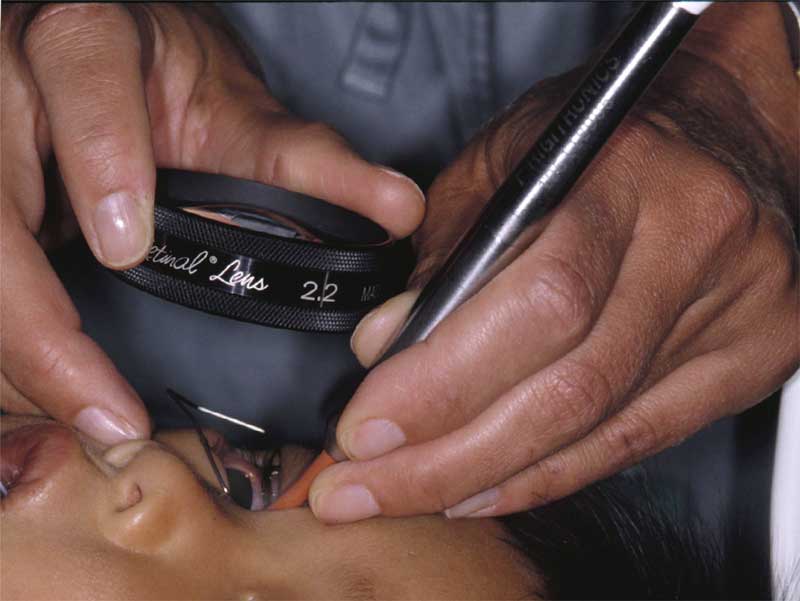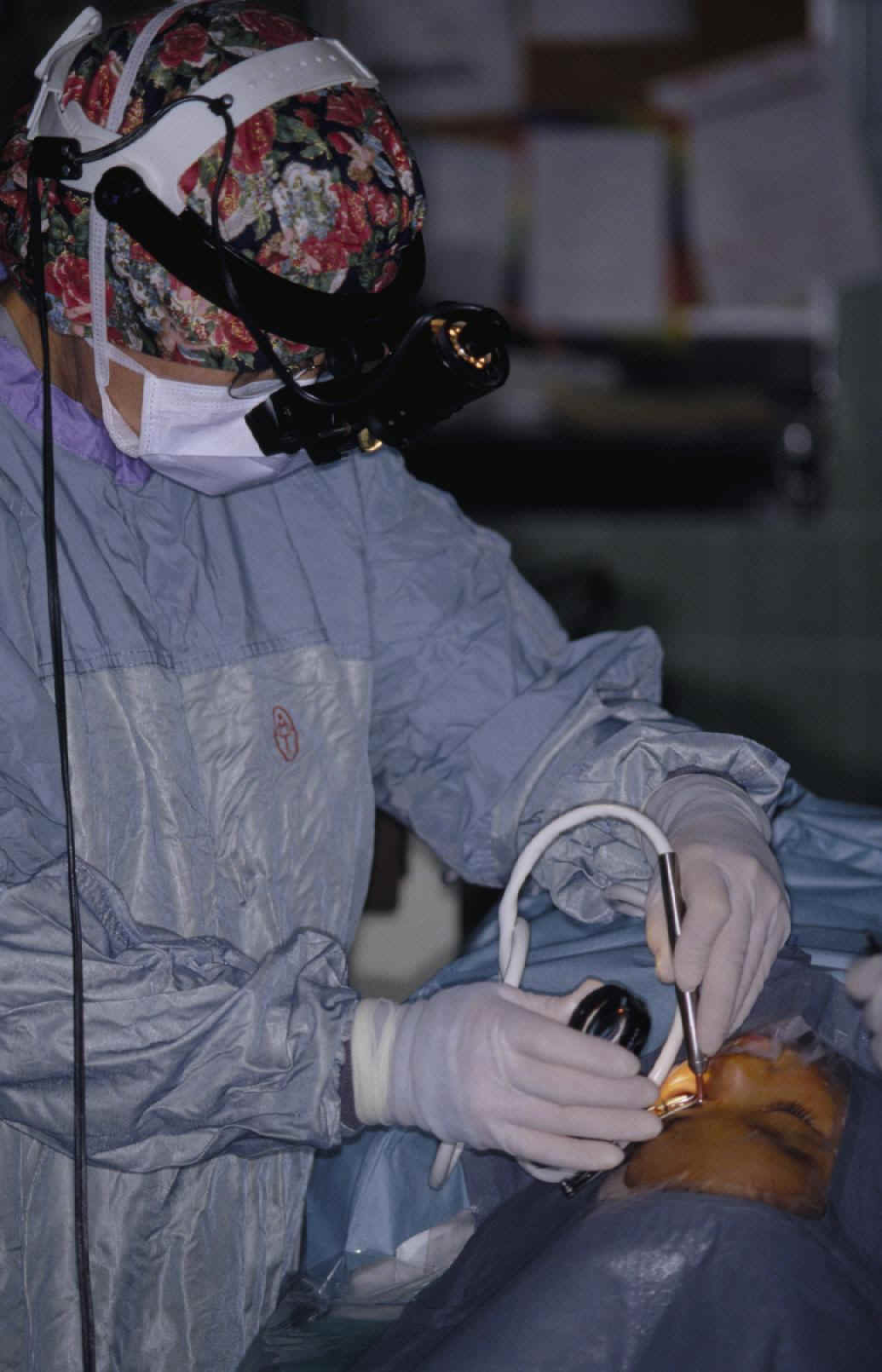
glossary
Amniocentesis A procedure that involves inserting a
needle through the abdomen to the uterus of a pregnant woman in order to obtain
the amniotic fluid which surrounds the developing baby. The amniotic fluid
can then be analyzed for the presence of the mistake that causes RB.
Anesthesia
(General) The complete absence of sensation and
consciousness induced by drugs given intravenously (through a vein) or
inhaled. Under a general anesthetic, the patient is asleep during the
surgery.
Anesthetist The doctor who administers and
monitors the anesthesia for the patients.
Bilateral RB
Children who develop RB tumors in both eyes have bilateral RB. This form
of RB is hereditary. A child with bilateral RB has a 50% chance of passing
RB to any of his future children.
Biopsy A biopsy is
the removal and examination of tissue from the living body in order to establish
an exact diagnosis. Biopsies are performed while a patient is under a
general anesthesia.
Blood Counts Blood counts are
monitored to make sure that your child's blood levels are normal. When
tumors develop, cells in the body divide rapidly. Chemotherapy acts on the
rapidly dividing cells in your child's body and affects the bone marrow (the
place where healthy blood cells are produced). While your child is
receiving chemotherapy, his blood counts will be taken twice a week (Monday
& Thursday) to make sure that he is not at risk for an infection,
necessitating hospitalization and antibiotics or in need of a blood transfusion.
Only a small amount of blood is needed to monitor your child's blood
counts. The blood is taken from your child by a finger prick. Taking
blood from your child in this way reduces the number of needles he receives and,
therefore, reduces his discomfort.
Bone Marrow Bone
marrow is a collection if special cells inside the long bones. It is where
new blood cells are produced.
Bone Marrow Aspiration
A procedure that involves the removal of a small amount of bone marrow, usually
from the hip bone while the child is asleep during an EUA. The bone marrow
sample is analyzed for the presence of cancer cells that may have spread from
the eyes through the blood.
Cancer Cancer is a
general term used from more than 100 diseases. In cancer, cells are
abnormal and grow in an uncontrolled way. The resulting tumor can invade
and destroy surrounding normal tissues. Cancer cells from the tumor can
spread through the blood or lymph to other parts of the body.
Cataract
A cataract is a lens that is no longer transparent, but rather is opaque
(no, or little light can pass through it). As a result of the lens
transparency, the eye's visual function is significantly reduced and in some
cases completely absent. The surgical removal of the cataract and the
insertion of a special contact lens in the place can retrieve a degree of
vision. The patient should get back some of the lost vision after the surgery,
but will require the use of corrective lenses.
CBC Complete blood count.
Chemotherapy
Chemotherapy is a treatment using special drugs to control cancer cells.
Conformer
A conformer is a plastic shield similar to a prosthetic eye that is placed
temporarily under the eyelid at the time of the enucleation surgery. The
custom-made prosthetic eye later replaces it.
Cornea
The clear outer portion of the eye. It allows light into the
eye.

 Cryotherapy
Cryotherapy is a form of focal therapy whereby a frozen probe is held to the
outside of the eye directly opposite a tumor. The probe freezes the tumor
turning it into an iceball. As the frozen tumor thaws the cells break down
and are destroyed. A session of cryotherapy usually involves 3 cycles of
freeze and thaw for each tumor. Cryotherapy is performed on your child
while he is under a general anesthetic.
Cryotherapy
Cryotherapy is a form of focal therapy whereby a frozen probe is held to the
outside of the eye directly opposite a tumor. The probe freezes the tumor
turning it into an iceball. As the frozen tumor thaws the cells break down
and are destroyed. A session of cryotherapy usually involves 3 cycles of
freeze and thaw for each tumor. Cryotherapy is performed on your child
while he is under a general anesthetic.
CT Scan A
special x-ray used to examine parts of the body especially the head, i.e. the
eyes and optic nerve.
CSF (Cerebral Spinal Fluid)
Cerebral Spinal Fluid is the fluid that surrounds the brain and spinal cord.
Diagnosis
The name for the disease or condition. The diagnosis is determined after
the doctor evaluates the findings from a physical or eye exam and lab and other
tests.
Dilate To dilate something is to make it wider
or larger. To see inside the eye it is necessary to dilate the pupil with
eye drops.
DNA (Deoxyribonucleic acid)
Enucleation
The surgical removal of the eyeball, leaving the eye muscles, lids and
surrounding structures.
EUA (Examination Under Anaesthesia)
An examination of the entire area of your child's eye while he is under a
general anaesthetic. EUAs are used to monitor the state of the RB tumors
in your child's eye(s). Once his eyes are mature (at around 6-7 years of
age) EUAs can be replaced with eye exams in the Ophthalmology clinic. The
child must be able to cooperate fully during the eye exam for it to be as
effective as an EUA.
External Beam Radiation Energy
waves given off by certain substances or generated electronically that are used
to treat as disease. When used for treatment, these waves are directed to
a tumor in order to destroy or inactivate it.
Extraocular
Disease Disease that exists or spreads outside of the
eye(s).
Focal Therapy Focal therapy is treatment
applied directly to individual tumors. Generally it is used to treat
small, non-visually threatening tumors. Focal therapy can be used as a
primary treatment plan, however, it is also usually used in combination with
chemotherapy. Focal therapy includes 3 different types of treatment (laser
therapy, cryotherapy and radioactive plaque). These are used individually
to treat specific sizes and locations of tumors, but are often used in
combination throughout the treatment of a single child.
Fovea
The part of the macula adapted for most acute vision and colour vision.
Gene
The biological component that carries the information that determines the
characteristics of each individual person. Genes are the information that is
passed on from parents to offspring.
Genetic A
condition that has a hereditary component.
Heredity
The genetic transmission of a particular quality of trait from one parent to
their children.
HSC The Hospital for Sick Children
Implant
A plastic, silicone or coral sphere that is placed in the eye socket after the
surgical removal of an eyeball. It maintains the shape of the front of the
eye and supports the prosthetic eye.
Informed Consent
This is the process by which a patient and or his family learn about all of the
aspects of a medical treatment and its benefits and risks before agreeing to be
treated. It is a very important part of any medical procedure.
Treatment cannot begin until informed consent has been obtained.
Indirect
Ophthalmoscope An instrument that shines a bright light
through your child's pupil and allows an ophthalmologist to see your child's
retina. The use of an indirect ophthalmoscope is not painful for your
child, however, it can be uncomfortable for him because of the bright beam of
light which has to shine through a dilated pupil. For your children, the
indirect ophthalmoscope is often used to examine a child who is asleep during an
EUA.
Intravenous Injection into a vein.
Iris
The coloured part of the eye. The iris is responsible for controlling the
amount of light that enters the eye.
 Laser A very
narrow, high-energy beam of light used to destroy tumor tissue.
(See picture to the left).
Laser A very
narrow, high-energy beam of light used to destroy tumor tissue.
(See picture to the left).
Lens
A clear structure in the eye which focuses light on the retina, in the same way
the lens of a camera focuses light on film.
Leukocoria
A condition characterized by the appearance of a whitish reflex or mass in or
behind the pupil. Leukocoria is also referred to as a Cat's eye reflex,
because its appearance is similar to that of a cat's eye.
Lumbar Puncture(LP) If retinoblastoma has spread to the brain, the tumor
cells may be floating in the cerebral spinal fluid (CSF) which bathes the brain
and the spinal cord. A lumbar puncture can test for the presence of these
tumor cells. To obtain a sample of the CSF for testing, a small amount of
the fluid is drawn through a narrow needle at the base of the spine.
Macula A small area at the back of the eye in the light sensitive layer (the retina)
which allows us to see fine detail and colour. The closer a tumor a treatment
scar is to the macula, the poorer the outcome for remaining vision.
Malignant
The tendency of cells to grow without control and spread to other parts of the
body possibly resulting in death.
Metastasis The
migration of cancer cells from the original tumor site through the blood or
lymph vessels to other parts of the body possibly resulting in death.
Mutation
A permanent change in the genetic material of a person or an organism.
MRI
(Magnetic Resonance Imaging) An imaging technique similar
to a CAT scan but not using x-rays. It is useful in displaying specific
characteristics of the brain and eye.
Naturopathy A
drugless system of therapy and treatment.
Ocularist A
specialist who designs, makes and fits prosthetic (artificial) eyes.
Oncologist
A doctor who specializes in chemotherapy treatment for cancer.
Ophthalmologist
A doctor who specializes in the medical and surgical treatment of eye diseases.
Optic
Nerve The nerve that connects the eye to the brain.
Port-o-Cath A device that is surgically inserted under the skin with a tube leading into one
of the large veins leading to the heart, it is used to deliver chemotherapy
drugs into the blood without risk of the drugs leaking into the normal tissue.
Prechemo-cryotherapy
Prechemo-cryotherapy refers to the use of cryotherapy less than 72 hours before
chemotherapy to increase the penetration of the chemotherapy drugs into the eye.
Prosthesis
An artificial substitute for a missing body part, used for functional or
cosmetic reasons or both.
Prosthetic Eye The
custom-made artificial eye that sits in the orbit of the enucleated eye.
Protocol
The outline or plan of treatment.
Pupil The opening
at the centre of the eye, through which light enters the eye.
Radiation
Oncologist An oncologist who specializes in the use of
radiation therapy as a treatment for cancer.
Radioactive Plaque
A form of focal therapy whereby a thin flat disk filled with a radioactive
substance is attached to the eye directly over the tumor. It is designed
to provide a carefully measured amount of radiation to the tumor.
Recurrence
The return of symptoms after a remission.
Retina
Nerve tissue lining the back of the eye that detects light and information and
sends it to the brain.
Retinal detachment When the
retina has pulled away from the underlying layers of the inner eye.
RetCam
High resolution camera that takes pictures of the retina and retinoblastoma
tumors.
Retinoblastoma (RB) A rare form of cancer
which causes tumors to grow on the retina of children. In most cases, the tumors
began developing before the child was born. RB can affect both eyes
(bilateral RB) or it can affect only one eye (unilateral RB). RB is caused
by a mutation in the developing retina cells of the child. This mutation
can either have been inherited from either parent or it can be just a
spontaneous mistake. RB is completely cured in 96% of the cases with
modern medical care. While RB is a genetic disease, only about 5-8% of
families have a positive family history. In most cases, the affected child
is the first family member to have RB.
Retinoma A
rare growth that simulates retinoblastoma and is caused by the same genetic
changes, but stops growing without needing treatment.
RB Gene
The piece of DNA that causes retinoblastoma. When the two copies of the
gene are damaged in a cell of infant retina, tumor forms.
Sclera
The white outer covering of the eye.
Strabismus An
inward or outward turning of one or both eyes.
Tumor
New growth of tissue in which the multiplication of cells is uncontrolled and
progressive.
UBM (Ultrasoundbiomicroscopy) A high
frequency ultrasound that displays an image of the anterior (front) part of the
eye. UBM is highly effective in the detection and monitoring of tumors
that can not be seen with other imaging devices.
Ultrasound (B-Scan)
B-Scan ultrasound is a device used for evaluation structures that cannot be seen
directly. High frequency sound waves are reflected by eye tissues and
orbital structures and are converted into electric pulses, which are displayed
as bright spots on a black background. It provides a cross-sectional view
of tissues.
Unilateral RB A child with unilateral RB
has tumor only in one eye. In most cases, unilateral RB is not
hereditary. However, 15% of children with unilateral RB do have the
hereditary form of RB and so each of their children will have a 50% chance of
developing RB.
Vitreous The transparent jelly
substance that fills the inside the eye and helps to maintain the internal
pressure within the eye and the external shape of the eye.
Vitreous seeding Vitreous seeding refers to little pieces of RB
tumor that have broken away and are floating freely in the vitreous.
Vitreous seeds are dangerous because they can potentially land on the retina and
begin growing into new tumors. They are also difficult to treat when they are
floating in the vitreous, because they are too small and free-moving to treat
with laser. They also do not respond very well to chemotherapy as they are
not attached to a blood supply.
All pictures courtesy of The Hospital for
Sick Children Toronto, Ontario






